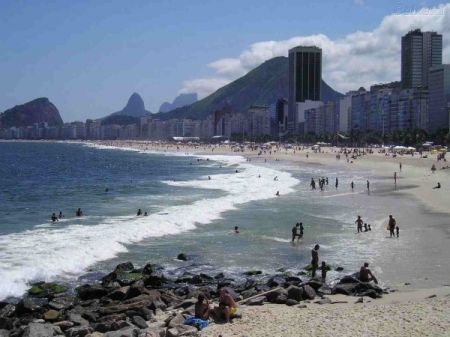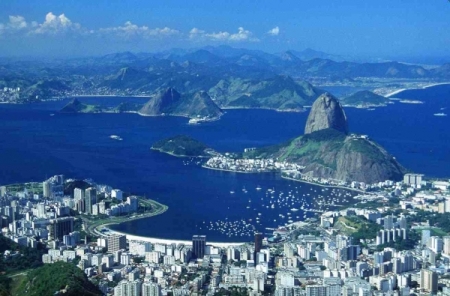The city is capital of the state of Rio de Janeiro, which encompasses
most of Brazil’s major tourist attractions has been justly dubbed the
“Marvellous City”, mainly owing to its spectacular location, beaches,
views and its world-famous carnival.
The city throbs to the infectious beat of Brazilian music and is the
main source of Brazil’s national culture. The annual carnival, known
simply as Carnaval, draws together the population of the city from the
rich to the poor who take to the streets for the world’s largest samba
parade on the Sambodromo. Rio is also one of the most densely populated
places on earth with extreme poverty in its favellas (slums). The
majority of the 7 million inhabitants put aside their povery and thrive
on dance, drink, beach, sport and sun.
The international tourist crowd take advantage of Rio’s ritzy side –
there are innumerable opportunities to be decadent but Rio also has much
to offer the budget traveller. There are cheap hotels and restaurants
aplenty, and the beach is a free entertainment zone.
Locality:
Rio De Janeiro is situated in SE Brazil, in the state of Minas Gerais
on the Atlantic coast. Rio is 716 mls SE of the capital Brasilia, 269
mls E of Sao Paulo (the country’s largest city). The city’s
international airport (Galeao) is in the N outskirts, about 13 mls N of
the city centre.
Rio has broad appeal suiting both younger and older couples and
families. Not particularly suited to the singles market but the area
does offer good nightlife. The main draw to the area is undoubtedly the
weather, beaches and sightseeing from Rio’s two main attractions: Sugar
Loaf Mountain and the famous Statue of Christ on the top of the
Corcovado mountain.
Popular attractions include:
Amsterdam Sauer Museum – On Ipanema’s Diamond Row a
block away from the Praca da Paz, this museum has a replica of a mine,
and a variety of rough stones and gems in virtually every imaginable
color.
Rua Garcia D’ Avila, 105 – Ipanema
Botanical Gardens – More than 7,000 varieties of
plants, herbarium, aquarium and a library are at these gardens founded
in 1908. Bird-watchers are advised to show up early morning since 140
species have been spotted including flycatchers and tanagers, plus the
American hawk. The 1992 Earth Summit spurred many improvements including
a new Orquidario, an enlarged bookshop.
Near the Parque Laje at R. Jardim Botanico 414.
Carnival and Carnival Museum – On the Friday before
Shrove Tuesday, the mayor of Rio symbolically hands over city keys to
King Momo, signifying start of an incomparable five-day party. Special
bandstands throughout the city are built for parade viewing. Far from
being a mere tourist attraction, the Carnival parade is a culmination of
intense activity by community groups. To understand different facets of
the parade, the small carnival museum in the Sambodromo has photographs
and an informative Engish-speaking staff.
Copacabana, Ipanema and other Beaches – With more
than 50 miles of beach shoreline, famed beaches such as Copacabana and
Ipanema are far more than tourist magnets, serving as an integral port
of local life as playgrounds, gyms, and places to meet, eat, drink and
make merry. Framed with black and white mosaic sidewalks and lined with
kiosks, Copacabana is a hot spot day and night with lifeguard posts,
public showers, hotels, bars and open-air restaurants. Ipanema with its
elite shops and restaurants, while more subdued, are a bit more
sophisticated. Leblon is also popular and Barra beach, the city’s
largest and favored by the younger crowd, is known for surfing and
windsurfing.
Corcovado and the Statue of Christ – Atop Corcovado
mountain, at 2,330 feet, the Statue of Christ the Redeemer ranks among
the world’s best known and most-visited monuments. Access starts in the
Cosme Vehlo District, aboard a miniature train running through the steep
Atlantic Rainforest up to the foot of the statue. The train ride
provides stunning glimpses of Rio from assorted angles. A road also
stretches up to the summit. The Statue, faced with a soapstone mosaic in
art nouveau style, is reached via steep steps. The climb is worth it,
with the view of Tijuca National Park spreading out below nothing short
of spectacular. Corcovado is open daily from 9 a.m. to 6 p.m.
Culinary Sensations – The Cariocas take food quite
seriously, with taste temptations on every corner, from juice bars (a
Rio trademark) to sophisticated dining enclaves. In fact, the great
melting pot of the Brazilian culinary heritage finds its broadest
expression in Rio, where restaurants offer not only traditional
Brazilian fare, but also excellent French, Italian, Japanese and Indian
dishes. Amazonia’s wealth of fresh water fish including pirarucu,
surubim and tucunare – familiar on menus throughout Brazil — are now
showing up at the once all-meat barbecue houses. From the northeast
region come such historic Portuguese dishes as Sopa Leao Velso (a knife
and fork fish stew) and moquecas (spicy fish stews). Bahian food was
strongly influenced by slaves from the African coast in the 17th, 18th,
and 19th centuries and includes acaraje (dried shrimp and bean
fritters), moqueca de siri mole (soft-shell crab stew) and bob d de
camarao (shrimp casserole). Two Bahian desserts widely favored are
cocada (a sweet coconut confection) and quindim (sticky coconut
cupcakes), and ice creams and sorbets are another delight in tropical
flavors such a guava, cupuacu and mango. Rio de Janeiro was originally
responsible for the feijoada (black bean cassoulet), a “Saturday” dish
now served virtually any day all over Brazil. Rice, stir-fried kale,
farofa and thinly sliced oranges are its accompaniments. From the south,
comes churrasco (or barbecue), an assortment of spit-roasted meat –
alligator and wild boar have joined more traditional beef, pork, chicken
and sausages — complemented by salads and side dishes. Budget-minded
adventurers may want to investigate the kilo restaurants, offering salad
buffets, hot and cold dishes and assorted desserts.
H. Stern Gem Museum – One big sparkling attraction
for gem lovers is the gem museum at the world headquarters for H. Stern.
Workshop tours showcase intricate steps in transforming a rough
gemstone into a gorgeous jewel. The museum, visited on request, features
Mr. Stern’s private collection of tourmalines and a variety of other
gemstones. Free tours can be arranged by hotel concierges or H. Stern
representatives in hotels.
Maracana Stadium – One of the world’s largest sports
stadiums, this football arena has seating for 200,000, and attendance
(even for non football fans) is worthwhile for the samba bands. Guided
tours (in Portuguese) are offered of grounds and the museum.
Museo Carmen Miranda – On display are a collection
of gowns and head-pieces for the diminutive Brazilian songstress Carmen
Miranda who was oft criticized by Brazilians for having become too
“Americanized.” Her first major appearance in her famed baiana costume
was in the 1939 movie Banana Terra, and from 1940 to 1953 she starred in
14 Hollywood productions.The entertainer who said all she needed to be
happy was “a good bowl of soup and the freedom to sing” died of a heart
attack at age 46 after collapsing on stage during a live Jimmy Durante
show. She is buried at Cemiterio Sa Joao Batista in the Botafogo.
Museo de Arte Moderna – A disastrous fire struck
this spectacular building in 1978, forcing need for rebuilding the
museum’s collection, and several countries have donated to the cause.
Exhibits include contemporary Brazilian works by Candido Portinari from
the 1940s and 1950s, along with drawings and etchings by Gregorio
Gruber.
Museum of the Indian – Dedicated to native
Brazilians, their art and culture, this museum showcases, pottery, wood,
straw and feathers used by tribes from throughout the sprawling
country.
Rua das Palmeiras, 55, Botafogo.
Museum of the Republic – This was the Brazilian
“White House” where presidents worked when Rio de Janeiro was the
country’s capital. Now it encompases exhibitions, music, theater,
cinema, video, a bookshop, and a restaurant. This is the first Latin
American museum with an automated reference desk, giving access to more
than 20,000 books and 80,000 documents.
Rua do Catete, 153
National War Monument – Saluting Brazil’s dead from
World War II, this memorial takes the form of two columns supporting a
slightly curved slab representing two palms uplifted to heaven. Remains
of Brazilian soldiers killed in Italy in 1944-45 are in the crypt, open
Tuesdays through Sundays. Beach attire including rubber-thonged sandals
are not permitted.
At the city end of the park, opposite Praca Paris.
Sambodromo – A center for Carnival activity,
Sambodromo seats 60,000 and handles sporting events, conferences and
concerts the rest of the year. The best boxes, reserved for tourists and
VIPs, have seats closest to the parade.
R. Marques de Sapucari, Cidade Nova.
Shopping Rio – SAARA, the largest ethnic market in
downtown Rio, dazzles with knockdown prices for clothing and exotic
foodstuffs. Shopping malls are excellent for comfort and safety. Big
sales take place in January and August. Bargaining for discounts is
often practiced, yet success generally occurs only in the smaller,
owner-operated shops or in the markets. Rio is known the world over for
beach wear, towels and other summer accessories. Precious stones, from
amethyst and aquamarine to topaz and tourmaline can be good buys. Open
air markets unfold at the end of the day on the Copacabana beachfront
between Rual Miguel Lemos and Rua Djalma Ulrich and on Sundays at the
Feirarte, known as the Hippie Market on Praca General Osorio in Ipanema.
A thriving antiques trade extends from jewelry to furnishings and
carpets.
Sporting Options – Popular Rio beach sports include
volleyball, beach football, and frescobol (a form of tennis played with a
solid wooden racket and a rubber ball). Football is the national sport
with big games at Maracana stadium. Also big are golf, hang-gliding,
parachuting, cycling, bowling, diving, squash, tennis, water-skiing and
windsurfing.
Sugar Loaf – Without doubt, the most dramatic
introduction to Rio is by sea, as Sugar Loaf Mountain comes into view
for the many cruise ships calling. Once arrived at Sugar Loaf, the
887-foot belvedere is the only site for viewing the whole of Copacabana
beach. Because the best time to visit Sugar Loaf is late afternoon or
early evening, tours typically end here. The summit is reached by a
two-step cable car. The first stage arrives at the Morro da Urca, at 550
feet, which has a restaurant, amphitheatre, and a good view of the
Botafogo Bay and the Yacht Club. Stage two proceeds to Sugar Loaf
itself, named for resemblance to loaves of sugar used by the Portuguese
shortly after discovery. Sugar loaf is open daily from 8 a.m. to 10 p.m.
Đăng ký:
Đăng Nhận xét (Atom)







0 comments:
Đăng nhận xét